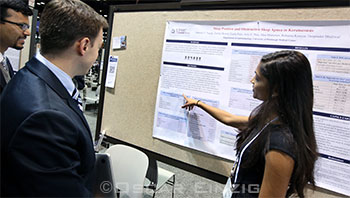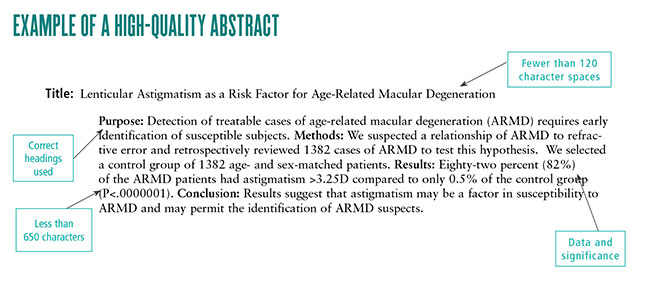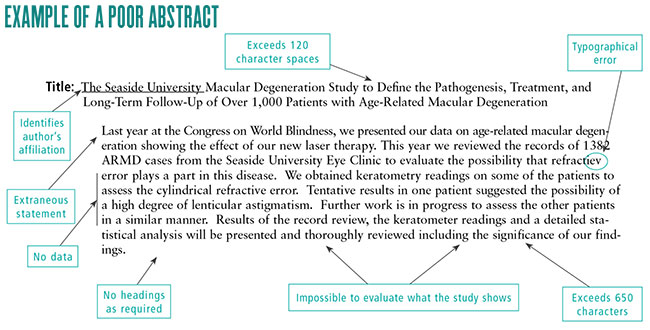By By Michael P. Mott, Contributing Writer
Download PDF
At AAO 2015 in Las Vegas, you will surely be intrigued by a paper or poster presentation, absorbed by a new surgical technique via the video program, or inspired by an instruction course. The chances of finding an engrossing educational experience are very good because the Annual Meeting Program Committee (AMPC) members dedicate months to selecting the most original, clinically relevant, and educational subjects for annual meeting presentations. Where does the AMPC get this material? From ophthalmologists like you.
Got something to share? Do you have study results, a surgical technique, or clinical practices that could benefit your colleagues? Consider throwing your hat in the ring to present at next year’s annual meeting. Not only will you engage your peers at the most important ophthalmology gathering in the world but you also will benefit by advancing your career and gaining exposure for your work—and earn Academy Achievement Award points in the process.
How to submit an idea? Submissions must be in the form of an abstract, and at least 1 of the abstract authors must be an Academy member.
How many submissions are accepted? Because there is such a high level of interest in becoming a presenter, many more abstracts are submitted than can be accepted, and they undergo extremely competitive review. In 2015, acceptance rates were 53% for instruction courses, 30% for papers/posters, and 24% for videos.
 |
Posters get wide exposure, as many are covered in the popular poster tours, and they are available online during the meeting and remain in the archives.
|
Know the do’s and don’ts of the submission process. In this article, 3 veterans of the review process share their insights into what makes a good submission and how you can improve your chances for acceptance. Their advice—which was first published in the 2013 Academy News, the convention news tabloid—has helped raise the bar for abstract submissions. To improve your chances of presenting at AAO 2016, read on.
Abstracts
Whether you want to present a paper or poster, teach an instruction course, or take part in the video program, you must start with an abstract.
The first step: submit an abstract. To get in the running, you must submit an abstract—and in some cases, supplemental materials—by the 2016 deadlines; the first of these deadlines is approaching fast, in January. (See “2016 Online Submitter Deadlines.”) The abstract is the single most important factor in the selection committee’s decision.
The protocol for abstract submissions varies by type of presentation. For example, to avoid bias, paper and poster abstracts are reviewed in a masked fashion; the AMPC asks that author names and affiliations be left out of these submissions. However, for instruction courses and videos, the names of faculty and producers are required. No matter what the protocol is for your submission, you can be sure that all abstracts of the same type are reviewed on equal footing.
So how can you make your abstract stand out to the reviewers? The first steps are paying close attention to the online submitter instructions and using sound writing mechanics.
Follow the instructions. Obvious as it sounds, it’s important to follow the abstract instructions explicitly outlined on the Academy website. For example, staying within the character/word count is imperative. “The online submitter forces the author to put their thoughts in an orderly and cohesive fashion so that we can follow them,” said William J. Fishkind, MD, FACS, who is now Associate Secretary for Annual Meeting and Chair of the AMPC. “If an abstract is confusing and not organized in the proper order, the reviewer can get lost very quickly, and that abstract will go nowhere in our review simply because of its organization and construction.”

Make it readable. A successful abstract must also be well written. Former AMPC Retina/Vitreous Subcommittee Chair (2013) John T. Thompson, MD, recommended beginning the writing process at least a week or two before the deadline. Many submissions come in close to the deadline, Dr. Thompson said. “I think because of the time pressure, people make careless grammatical mistakes and misspellings.” Taking the time to write drafts and hone them down is extremely important. “As the authors continue to revise the abstract, it will get better and better,” Dr. Thompson said. “It’s very easy for the committee to recognize polished abstracts, as opposed to those that are first drafts. You have a limited number of words, and every word counts.”
Apart from these general principles, each type of presentation has its own guidelines, and paying attention to the relevant details boosts the chance of your presentation making it to the annual meeting.
Papers and Posters
If you are submitting an abstract as a paper or a poster, there are some specific points that the AMPC would like to emphasize.
Novel content. For paper and poster abstracts, the AMPC is mainly interested in work that is original and of interest to Academy members. According to former AMPC Chair (2013) Cynthia Mattox, MD, FACS, the presentation of novel research is “critically important” to the meeting. Therefore, an abstract is more likely to be accepted if the subject matter is innovative.
Relevant content. Academy membership consists largely of clinical ophthalmologists who focus on human research, so basic science studies involving animals are less relevant and less likely to be selected.
Data, data, data. The best way to represent your original research in the abstract is by using data points. The AMPC is on the lookout for numbers and whether there is enough statistical power to draw valid conclusions. Although the committee recognizes that there are space limitations to submissions, you can’t simply skip to a conclusion by stating, for example, that treatment A is better than treatment B. If comparisons are being made, include appropriate statistical measures—such as p values, confidence intervals, and/or standard deviations—as well as the actual data. “Just stating there is a 50% success rate for treatment A and a 65% success rate for treatment B doesn’t really tell us much,” Dr. Thompson said.
Keep in mind that reviewers understand that the data presented in the abstract are not as complete as what will be in the paper or presentation. A submission might be accepted without all of the data if the committee judges that the subject is of substantial interest; the abstract is well organized; and the study is well designed, randomized, and masked (if possible). Nevertheless, the better the data, the better your chances of acceptance.
Ophthalmology
If you want to present a paper or poster at the annual meeting, it is important to remember that Ophthalmology has right of first refusal. You shouldn’t submit an abstract if it has been previously published or submitted for publication outside of Ophthalmology. With the rapid turnaround of editorial right of first refusal, you can quickly learn if your material is of interest to the journal for publication; if not, you will then be considered released and able to submit to other journals.
|
Back it up. Authors need to report an adequate sample size, study duration, and follow-up period—as well as describe their methods clearly—in order to convey the study’s validity. A common mistake is to state that one treatment is inferior to another without saying how many patients were included. AMPC reviewers want to know, for example, whether a study included 10 patients or 1,000 patients. “Some abstracts omit this,” said Dr. Thompson, “and it becomes very hard to evaluate the study as a result.” It is important to represent your data in as few words as possible without omitting key information or painting broad generalizations. Concision, clarity, and care in the preparation of your abstract are important considerations in the AMPC’s deliberations.
Don’t limit yourself. Most authors are advised to allow the AMPC to consider the submission as either a paper or a poster. That way, the committee will evaluate the submission as a paper first; if the abstract isn’t the right fit for that type of presentation, it may still be accepted as a poster. Consider that in 2015 almost 3,000 paper/poster abstracts were submitted to AMPC; of these 106 were accepted as papers, and 539 were accepted as posters.
A paper? How does the AMPC make the decision between a paper and a poster? “There is limited time for paper presentations,” said Dr. Mattox. “We try to choose those that have the most interest and have the most high-quality research.” In other words, the AMPC wants the limited number of paper spots to go to those studies that have the biggest impact on the broadest range of ophthalmologists. In general, papers have more focused abstracts and study design, a clear-cut topic, and a larger number of subjects; and they are more conducive to audience discussion. Originality is also a key factor. “We are looking for something exciting that you can attend and say, ‘Holy cow, I learned this at the annual meeting. This is cutting edge,’” said Dr. Fishkind.

Or a poster? Posters, on the other hand, often present exciting topics, but they may be based on smaller studies or preliminary investigations, or they may appeal to more of a niche audience. For example, a case series of 5 patients with an extremely unusual form of endophthalmitis will more likely fall into the poster category. Additionally, some types of data can be presented more effectively in a poster, particularly if they are best depicted in highly detailed graphs or charts.
“Some authors are disappointed when they learn that their abstract was accepted as a poster instead of a paper, but posters have great visibility,” Dr. Mattox explained. “They are posted for 2 days, and most are covered in our popular poster tours, not to mention their online availability at the meeting and in the archives.”
Instruction Courses
Instruction courses are a breed apart from papers and posters and must stand out in unique ways.
Open it up to discussion. Instruction courses must include both a course outline and an abstract. The outline needs to be sufficiently detailed, including specific teaching points, to allow the AMPC to evaluate the quality of the course. The committee recommends that you develop and prepare this outline well in advance of writing the abstract. “In general,” Dr. Mattox noted, “we like to see very thorough, well-thought-out topics that can be realistically covered in the time allowed. We are particularly interested in having interactive formats that engage the smaller audiences and facilitate the learning process.”
Therefore, when developing the course outline, keep in mind that you are not limited to a traditional lecture style. The AMPC encourages submission of case-based presentations that promote audience participation and incorporate innovative teaching styles (as opposed to a standard lecture by a table of experts). “We also like discussion sections,” Dr. Thompson said. “When we evaluate the course outlines, we like to see that there is a chance for the audience to interact and ask questions.”
Abstracts. When reviewing course abstracts, the AMPC looks for several other elements as well. Will the course attract a reasonably sized audience? Is the course focused on a single area, or is it too broad? Will the course require more time than is available in the standard time slots? In general, priority is given to courses that can be presented in 1 hour.
Number of instructors. Try to realistically match the number of instructors to the time allocated. In general, the AMPC recommends a maximum of 5 instructors per course hour.
 |
The AMPC is especially interested in receiving new submissions for instruction courses in 2016. If you have an idea, please submit it.
|
Previously presented at the annual meeting? The AMPC also takes into account whether the course has been presented at previous annual meetings, and if so, whether it received positive attendee evaluations. “Because we have a limit on how many courses can be offered from a time and space standpoint,” Dr. Mattox noted, “we want to be sure that we have courses in each subspecialty area that cover the main topics. If there have been multiple submissions for the same topic, we often rely on past reviews of a prior course to guide us in selecting the best courses.”
First-timers. If you are new faculty interested in presenting a fresh topic, the AMPC wants to hear from you! Dr. Mattox has 3 important pieces of advice. 1) Review the prior annual meeting programs and select a topic that is not currently offered. 2) If you lecture to residents and fellows in your specialty, you already have the basis for expanding material into a course offering. 3) If your first submission is rejected, don’t be discouraged. You can always submit again in another year with a new twist or a more interactive learning format.
Videos
Although abstracts are required and should provide a clear description of the video, the most important element of the submission process is the video itself. Reviewers expect annual meeting videos to have the following characteristics.
Edit like a pro. Videos should be well organized and demonstrate an expert use of the medium. A common mistake is poor editing; videos that are too long or repetitive can make for tedious viewing. Edit your video to get your point across quickly and succinctly so that it fits within the allotted time. Dr. Thompson recommends emulating a professional style of editing. “I don’t mean that the editing has to be done by a videographer. But you want to have a video that has appropriate splicing to avoid long segments. You really want to have the video move forward and capture the attention of the reviewers and, ultimately, the Academy attendees.”
 |
Think about education, editing, and entertainment when producing your video submission.
|
Pay attention to audio. Another tip from the AMPC: Include narration that is clear and understandable and has brief intros. “It’s not good to have long introductions,” Dr. Thompson noted. “People shouldn’t be thanking their grandmothers here.” It also doesn’t hurt to convey the message in an entertaining fashion so it is more fun to watch.
Follow copyright law. To make your video more entertaining, you may want to add music or other elements. However, be careful about using music, graphics, film clips, or any material from other sources—you are responsible for obtaining appropriate permissions. Violation of copyright law—even unintentionally—can create a major issue for the Academy.
Aim to teach attendees something new. Videos should possess educational value on an original topic. The AMPC wants the viewer to come away with tangible knowledge. “The video shouldn’t just show a technique that people have been doing for 10 or 20 years,” Dr. Thompson said. “It’s helpful if it’s a new surgical approach or a new observation about a disease.”
Because of the desirability of original topics, as well as the fact that producers do not have to be physically present at the meeting, a video submission may be perfect for international ophthalmologists. “Many have a native English speaker narrate their videos, and submit videos that focus on diseases rarely seen outside of their countries—these are very instructive for U.S. physicians,” said Dr. Thompson. And it gives international members a way to connect with colleagues from other parts of the globe.
Keep them coming back for more. Dr. Fishkind added, “Hopefully, the videos are instructional to the point where the attendee will really want to come back to review the process over and over again.”
How to Get Started
Don’t forget this most important guideline: All presentations must follow the online submitter directions. The Academy Presenter Central portal guides you through the process. You will find complete instructions for submitting each type of presentation online, specific submission policies and particular requirements for each presentation type, important dates, and frequently asked questions. There is also a list of acceptable subject classifications for abstracts as well as a list of suggested course topics from previous years.
For more information, visit www.aao.org/2016 and click “Presenter Central” at the top of the page.
2016 Online Submitter Deadlines
Abstract Submissions Open:
Instruction Courses—Dec. 10, 2015 Papers/Posters—March 10, 2016 Videos—March 10, 2016
Abstract Submissions Close:
Instruction Courses—Jan. 12, 2016 Papers/Posters—April 12, 2016 Videos—April 12, 2016
|